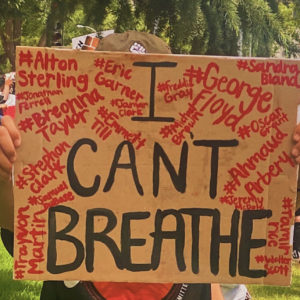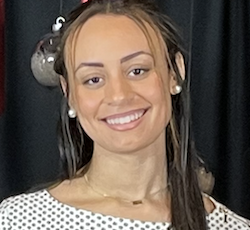Student Voices: Micayla Bozeman on 2020, Tyre Nichols, and police reform
As part of our mission to promote racial justice, SCRJ is creating space for student interns and research assistants to offer personal reflections and share independent perspectives on race that are important to them. Our first Student Voices essay is from Micayla Bozeman.
On May 30, 2020, I painted a cardboard sign. “I can’t breathe,” it read. In all black letters.

In red, I painted the names of George Floyd, Breonna Taylor, Ahmaud Arbery, Eric Garner, Travon Martin, Tamir Rice, Sandra Bland, and others. I painted the words “I can’t breathe” to represent the last words of George Floyd and to represent the way I felt emotionally. I wrote a poem about the feeling of constantly seeing Black people killed by the police.
My poem ended:
“I can’t breathe when I have to constantly defend why Black people deserve to have basic human rights.
I can’t breathe.
I can’t breathe when I think
Will my dad be next?
Will my brothers be next?
Will my nephews be next?
Will my friends be next?
Will I be next?
Every second of every day, I feel as though I can’t breathe.
I can’t breathe …
But I want the one being choked to death, for 8 minutes, while begging for my life.”
Almost three years later and nothing has changed. In fact, it has gotten worse. In 2022, there were at least 1,176 deaths by police in the United States. I am still painting names onto cardboard.
Following the alarming news of his death in January, I felt my heart beat fast and my breath get short as I painted a new name in red: Tyre Nichols. I could have painted 78 other names representing the death toll of U.S. police killings in 2023 so far. In early February, I also attended a vigil with 70 other Stanford students where we mourned the deaths of Black people in America who have lost their lives at the hands of the police. As Stanford students recited their poems, tears filled my eyes. I remembered the poem I wrote back in 2020, and reflected on how I am even more fearful now than I ever was before for the lives of my Black family members. I not only fear for my families’ lives off campus, but also for my own life on campus.
On the night of January 28, a police officer pointed his gun at a Black man in his car on Stanford’s campus. The University claims there is still an ongoing investigation by an “outside consultant,” but how did something like this happen in the first place? This incident leads me to question what Stanford’s $33.5 million public safety project is doing to “protect” us if we are still being targeted on our own campus. This unfair target on our backs sends the message that Stanford believes being Black is a crime. On the side of Green Library is a sign that says, “Know Justice, Know Peace,” but if Stanford can’t know justice, it shouldn’t get to know peace.
I am tired of painting names in red. I refuse to paint the name of a fellow Stanford student. Following the vigil, students marched to the Stanford University Department of Public Safety (SUDPS) demanding “cops off campus” and came up with a list of demands for Stanford in order to keep us safe. These demands include: the immediate defunding of the SUDPS; termination of the Memorandum of Understanding with Santa Clara County that gave rise to the SUDPS; ending the $2.5 million expansion of security cameras; redirection of security funding to address sexual violence on campus; and adding adequate trauma-informed, community-centered resources for survivors of sexual violence. While these demands may not solve the larger systemic issue around violent policing in the United States, they will set an example for how communities—and campuses like Stanford—can work with the people in them to build safer environments for everyone.
There is still a long way to go for Black students to feel safe, wanted, and welcomed by Stanford, and these student demands are just the beginning. Stanford students are not done fighting police violence and calling for an end to policing on campus—and neither am I. #NoMoreNames
______________________________________________

Micayla Bozeman, a senior from Lansing, Mich., is graduating with a major in Political Science and minor in Psychology in spring. For the past three summers, she has worked at the Social Concepts Lab studying racism and race representation in psychological research with Professor Steven Roberts; the Alameda County Public Defender’s Office in Oakland; and as a Bay Area Law School intern. In addition to her work at SCRJ, she is an intern for the Court Listening Project with Professor Matthew Clair. Micayla plans on attending law school.
To keep up with what Stanford students like MIcayla are doing to advocate for themselves, follow @slap_stanford on Instagram.
